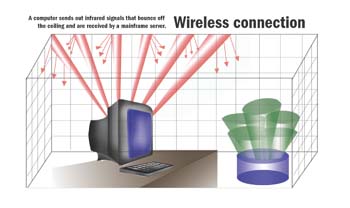Wireless communications — this time it is not about phones, but computer networks. Researchers at Penn State say they have found a way to connect a whole office through infrared beams.
"We want to make a whole lab wireless," said Mohsen Kavehrad, professor of electrical engineering
The original idea for Kavehrad's research came nine years ago during his work with a graduate student. Since that time, he has been working on a way to make his vision become a reality.
Kavehrad recently co-authored a paper with his research associate, Svetla Jivkova, that outlined the project in more detail.
In the model, each computer is equipped with an infrared beam that is sent through a holographic chip. The chip splits the single ray into a grid of infrared light. Most importantly, this grid is aimed at the ceiling, which is how the information coming from the computer is transmitted.
The ceiling reflects the beams from the computers to a receiving station. The ceiling cannot be dark because it would absorb rather than reflect the infrared light. A mainframe computer can accept the beams from all the computers and send information using
the same process, because each computer has a receiver as well as a transmitter.
"Wherever you are in a room, you will still get a signal. You will still get light from the rest of the spots," Jivkova said.
The speed of the system in a perfect scenario would be two gigabits per second, but in simulations it ran about a few hundred megabits per second.
The beams will not be a distraction for workers in the office, however. "You can't see them (because) of low levels of power," Kavehrad said.
The grid of infrared light is not thought to be harmful to people because the power outages of the infrared beams hover around one watt. Also, human beings have lived with the sun, which is the largest source of infrared light, since their inception.
Other light sources also can affect the network of infrared light. "They bother it a lot. (The receiver) is very sensitive to the whole spectrum of light," Jivkova said.
To try to counteract the problem, scientists are working on an optical filter, but they also are attempting to construct a holographic mirror, which would reject stray light.
Another drawback is that only computers in one room would be connected with each other. Unlike a wire, an infrared beam cannot be sent through a wall.
Other scientists have been researching techniques similar to these using radio waves. But, there is some discussion about the safety of radio waves in regard to how much radiation they emit.
Also, interference is another problem with radio waves. "Radio waves interfere with one another," Kavehrad said. The current experiments use 2.4-gigahertz frequency for their radio waves. "These are the same as (those from) microwaves, and (microwaves) will interfere with the signal," he said.
There is optimism that a running model using infrared beams could be completed soon if there is adequate funding. "We have everything figured out," Kavehrad said. "In six months, a whole network could be demonstrated (through infrared)."




